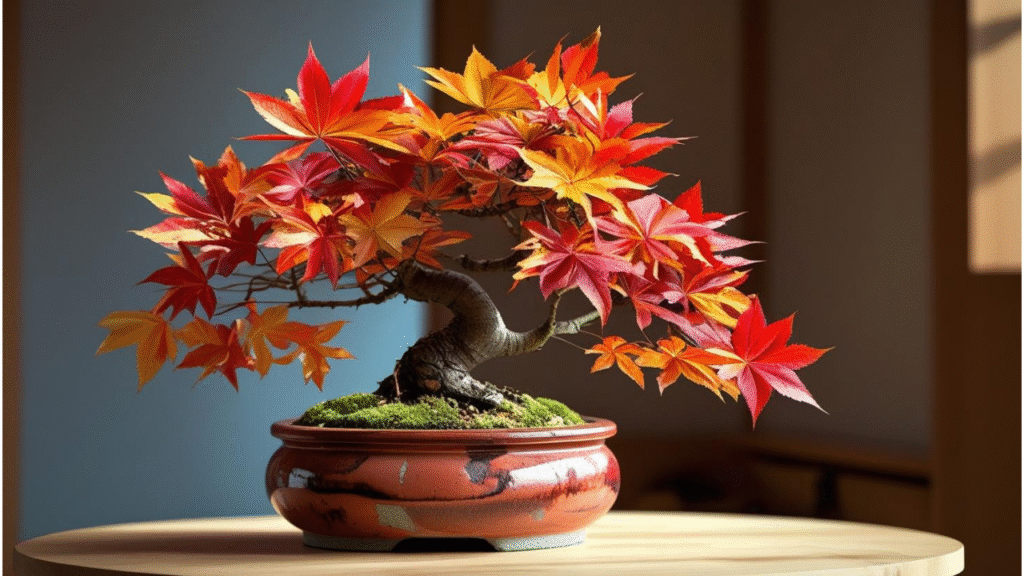
American Sweetgum Bonsai: The Ultimate Guide to Growing and Caring for Your Tree
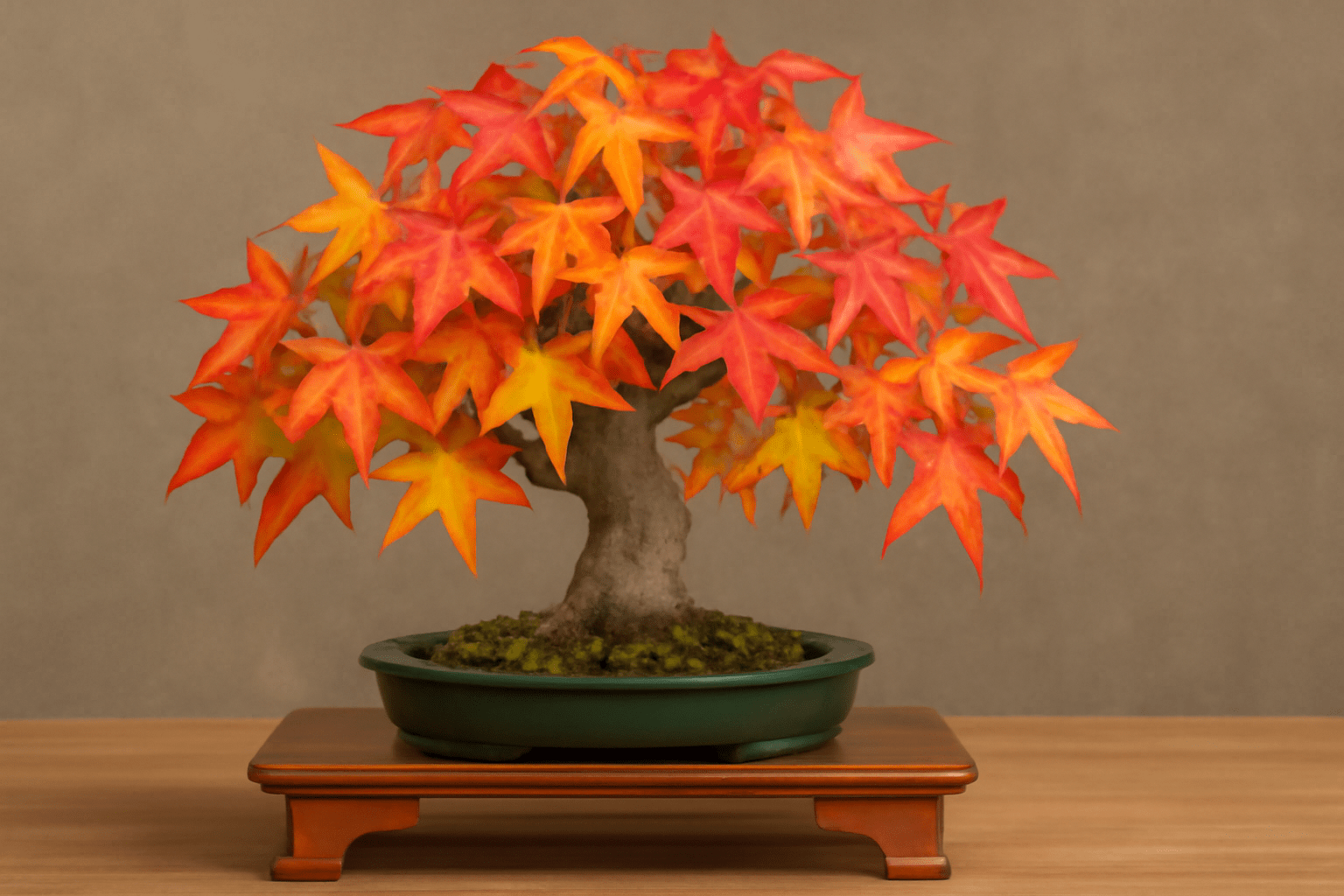
Table of Contents
Toggle🪴🌳 What Is an American Sweetgum Bonsai? 🌳🪴
The American Sweetgum Bonsai is a miniature version of the beautiful Liquidambar styraciflua tree, known for its vibrant star-shaped leaves 🌟 and striking fall colors 🍁. Native to North America, this tree is a popular choice for bonsai enthusiasts due to its unique appearance and relatively easy care requirements. Unlike traditional trees, bonsai trees like the American Sweetgum are cultivated to stay small and compact while retaining the full character of their full-sized counterparts. These trees can grow in small pots 🪴 and are shaped through pruning ✂️, wiring 🔗, and careful attention to their environment 🏡.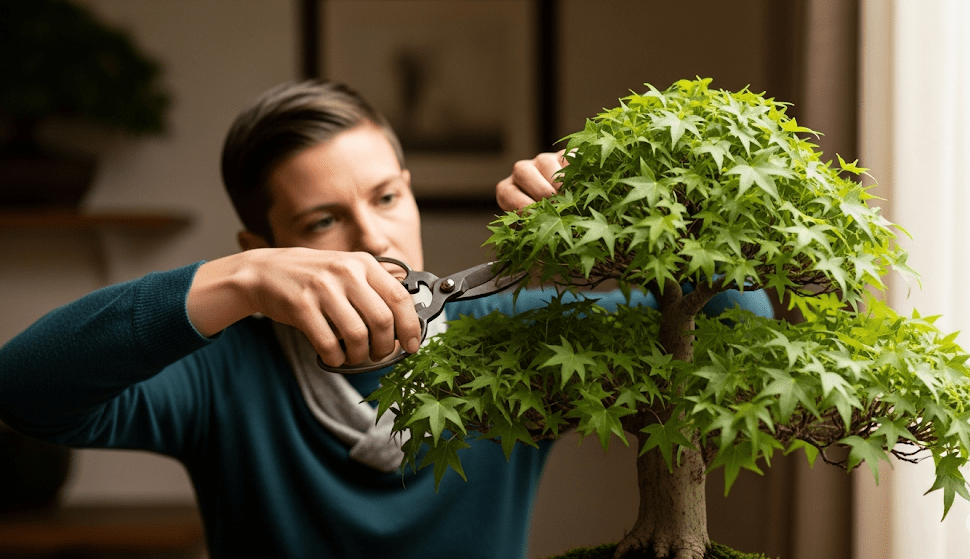
🍂🌱 Key Features of American Sweetgum Bonsai 🌱🍂
- Leaves: The signature star-shaped leaves 🌟 turn brilliant red, yellow, or orange in autumn 🍂, making it a showstopper in any bonsai collection 🌿.
- Trunk: The trunk has a rugged, textured appearance 🌳 that adds to the tree’s charm, especially when it’s trained properly through bonsai techniques 🪴.
- Growth: While it’s a slow grower 🌱 compared to other species, it adapts well to the pruning ✂️ and shaping necessary for bonsai 🌿.
🌟🌱 Why Grow American Sweetgum Bonsai? 🌱🌟
Growing an American Sweetgum Bonsai offers a host of unique benefits that make it an excellent choice for both beginner and experienced bonsai enthusiasts. Here’s why you should consider adding this stunning tree to your collection: 🌿🍁🌟 1. Striking Aesthetic Appeal 🌟🍁
The American Sweetgum Bonsai is a visual masterpiece! Its star-shaped leaves 🌟 are not only beautiful but also transform with the seasons. During fall, the leaves change to brilliant shades of red, orange, and yellow 🍂, adding vibrant color to any space 🏡. This seasonal transformation brings a dynamic element to your indoor or outdoor environment, making it a showpiece throughout the year 🌈.💧🌱 2. Easy to Care For 🌱💧
While it may seem like growing bonsai is complicated, the American Sweetgum Bonsai is relatively easy to care for 🌿, especially compared to other species 🌱. It thrives in both indoor and outdoor environments 🌤️ (with the right care), making it a flexible option for any bonsai grower 🪴. Plus, its care routine mainly revolves around proper pruning ✂️, watering 💧, and providing adequate sunlight ☀️.🪴🌳 3. Compact Size, Big Impact 🌳🪴
One of the biggest advantages of growing an American Sweetgum Bonsai is its compact size 🌿. Unlike full-sized Sweetgum trees 🌳, which can grow to impressive heights, the bonsai version stays manageable in small pots 🪴. This makes it perfect for apartments 🏢, offices 🏢, or smaller spaces 🏡 where you still want a touch of nature 🌱.😌🌱 4. Stress-Relieving Hobby 🌱😌
Bonsai care is not only about cultivating a beautiful plant 🌳 but also about developing a calming, mindful practice 🧘♂️. The process of trimming ✂️, shaping 🪴, and nurturing your tree 🌱 can help reduce stress 🧘♀️ and provide a sense of accomplishment 🏆. It’s a relaxing hobby that lets you connect with nature 🌿, even in the busiest environments 🌆.🗣️🌿 5. A Conversation Starter 🌿🗣️
With its unique beauty 🌟 and the intriguing process of bonsai cultivation 🪴, an American Sweetgum Bonsai is sure to catch the eye 👀 of anyone who enters your space. It’s a great conversation starter 💬, whether you’re showcasing your skills at a bonsai exhibit 🎨 or simply sharing your tree 🌳 with friends and family 👨👩👧👦. By growing an American Sweetgum Bonsai, you’re not just adding a plant 🌱 to your home—you’re introducing a dynamic, stunning, and rewarding tree 🌳 that brings beauty, calm 🧘♂️, and a touch of nature 🌿 into your everyday life. 🌱🪴🌳 Selecting the Right American Sweetgum Bonsai 🌳🪴
Choosing the right American Sweetgum Bonsai is the first step toward a successful and enjoyable bonsai journey. Here’s how to make sure you pick the best tree for your needs and skill level 😊: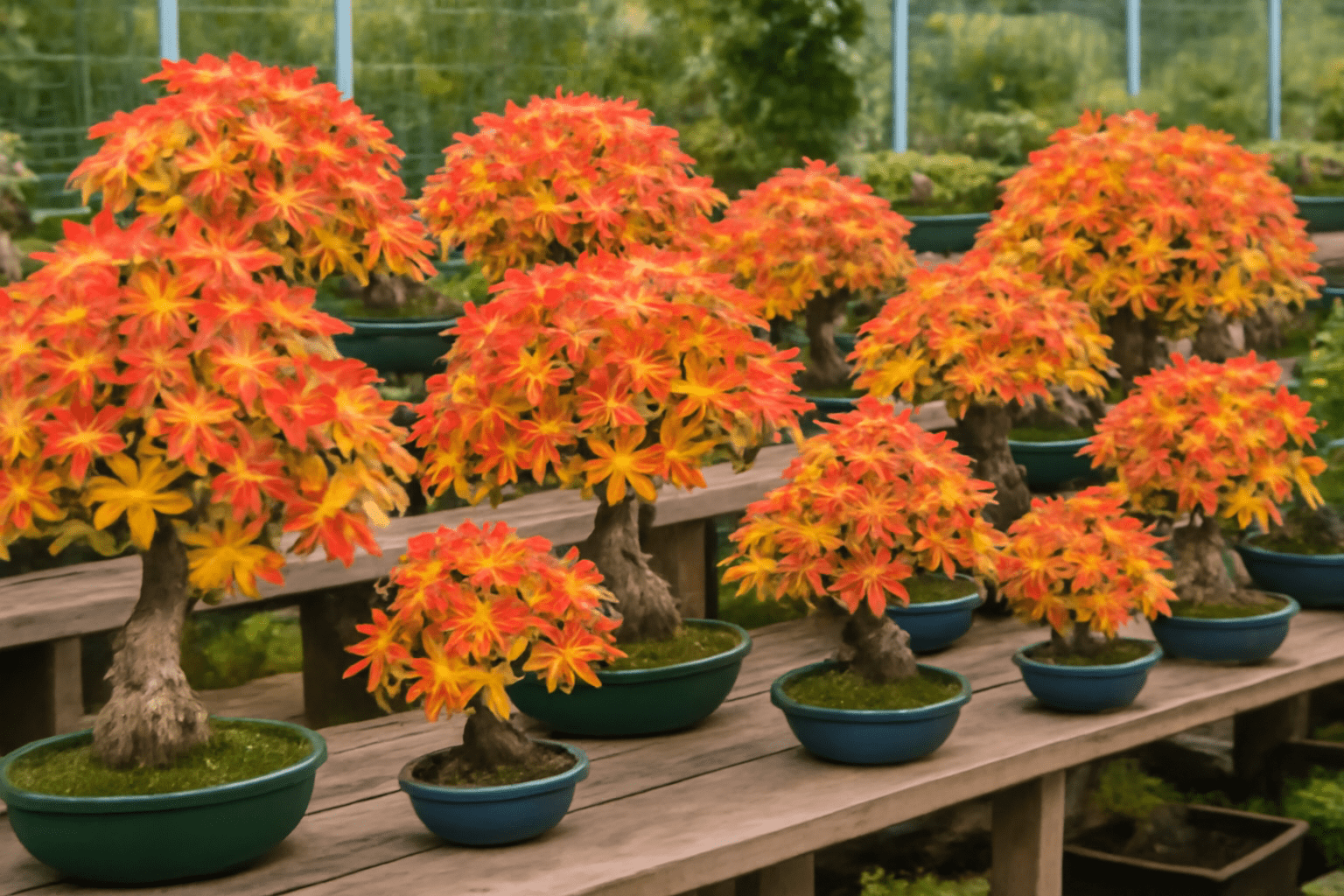
🛍️🌿 1. Where to Buy Your Sweetgum Bonsai 🌿🛍️
- Online Nurseries: Many online stores offer a wide range of American Sweetgum Bonsai options, often with the advantage of detailed descriptions and photos 📸. Look for reputable sellers with customer reviews to ensure you’re buying a healthy tree 🌱.
- Local Garden Centers: Buying locally gives you the advantage of inspecting the tree in person 👀. You can check for healthy leaves 🍃, a sturdy trunk 🌳, and good root structure 🌿.
- Bonsai Specialty Shops: These shops often carry bonsai trees that have been well cared for 🌱 and might offer expert advice 💬 to help you pick the perfect one.
📏🌱 2. Choosing the Right Size 🌱📏
The size of your bonsai will depend on your experience level and available space:- Small Bonsai (Beginner-Friendly): If you’re new to bonsai, look for a smaller tree (around 6–10 inches) 🌿. These are easier to manage and require less frequent pruning ✂️.
- Larger Bonsai (For Experienced Growers): If you have more experience, you may want to try a medium or larger tree (12–24 inches) 🌳. These trees offer more shaping potential and make a bolder statement in your home or garden 🏡.
🌳🌱 3. Tree Age Matters 🌱🌳
- Young Trees: Young American Sweetgum Bonsai trees (around 1-2 years old) 🌿 are more adaptable and easier to shape, making them ideal for beginners 👨🌾. They are more affordable 💰, but they’ll require more time and effort to shape ✂️.
- Mature Trees: Older trees (3+ years) 🌳 may already have a beautiful structure, reducing the time needed to shape them. However, they can be more expensive 💸 and may require more advanced care 🧑🌾.
✅🍃 4. Look for Healthy Trees 🍃✅
When selecting a Sweetgum Bonsai, here are a few things to look for:- Healthy Foliage: The leaves 🍃 should be vibrant and free from yellowing, wilting, or spots. Healthy leaves indicate a tree that’s well cared for 🌱.
- Strong Trunk: The trunk 🌳 should be thick and stable. A good trunk is the backbone of any bonsai and will help support future shaping ✂️.
- Well-Developed Roots: Gently remove the tree from its pot 🪴 to inspect the roots 🌱. Healthy roots should be white or light in color, and they should not be overly tangled or rotting 🚫.
🌞🏡 5. Consider Your Growing Environment 🏡🌞
Before buying, consider where you’ll keep your American Sweetgum Bonsai:- Indoor vs. Outdoor: Sweetgum trees 🌳 can thrive indoors with proper sunlight 🌞 or outdoors in mild climates 🌤️. Make sure the environment matches the tree’s needs—if you’re keeping it indoors, ensure it gets enough light 💡 or invest in a grow light 💡.
- Space Requirements: Ensure that the pot size 🪴, tree height 🌳, and care space 🏠 fit within your living space. If you’re limited on space, a smaller tree is a better option 🌱.
🪴🌱 Preparing for Bonsai Care: The Essentials 🌱🪴
Before you dive into growing your American Sweetgum Bonsai, it’s important to gather the right tools and materials. Proper preparation will ensure your tree stays healthy 🌱 and thrives. Here’s what you need to get started: 😊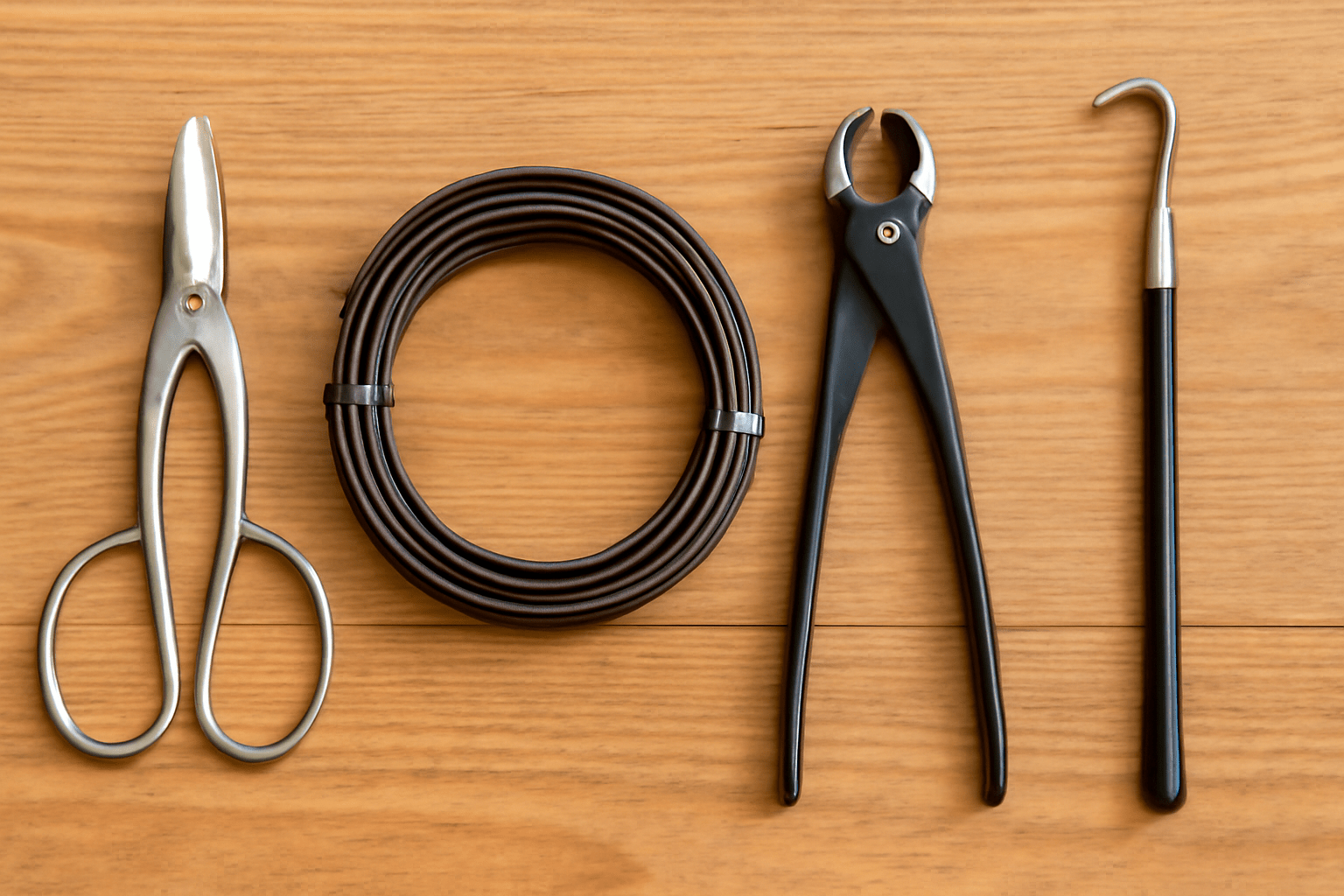
🛠️🌿 1. Essential Bonsai Tools 🌿🛠️
Having the right tools is crucial for shaping, pruning ✂️, and maintaining your bonsai tree. Here are the basics you’ll need:- Pruning Shears: To trim and shape your Sweetgum’s branches and leaves 🍃. Look for sharp, quality shears to make clean cuts ✂️.
- Concave Cutters: These are used for removing larger branches 🌳. They make a rounded cut that helps the tree heal more effectively 🌿.
- Wire: Bonsai wire helps you shape the branches and trunk 🌳 of your tree. Make sure to choose soft, flexible wire 🪢 that won’t damage the bark.
- Root Hook: This is helpful for gently untangling and spreading out the roots 🌱 when repotting your tree 🌳.
- Watering Can with a Fine Nozzle: A fine spray ensures your bonsai gets the right amount of water 💦 without disrupting the soil.
🪴🏺 2. Choosing the Right Pot 🏺🪴
The pot you choose is more than just decorative—it’s essential for your tree’s health 🌱.- Shallow Pot: Bonsai trees thrive in shallow pots 🪴 that limit root growth and help keep the tree small 🌳. Look for a pot that’s deep enough for the roots but not excessively large 🏺.
- Drainage Holes: Make sure the pot has adequate drainage holes 🌧️ to prevent waterlogging, which can lead to root rot 🌱.
- Material: Traditional bonsai pots are made from ceramic 🏺, which helps regulate moisture levels 💧. Avoid using pots that don’t allow for proper airflow and drainage 🌬️.
🌿🌱 3. Soil Mix for Bonsai Trees 🌱🌿
The right soil mix is key to providing proper drainage and nutrition for your American Sweetgum Bonsai 🌳. Here’s what to use:- Well-Draining Soil: Bonsai soil must allow water 💦 to pass through easily. A good mix includes akadama (clay) 🏺, pumice (volcanic rock) 🌋, and lava rock 🌋 for good aeration.
- Organic Matter: Add a small amount of organic compost 🌱 or pine bark 🍂 to improve soil structure and provide essential nutrients.
- Avoid Regular Potting Soil: Regular soil can be too dense, causing root rot 🛑 and poor drainage, which is not ideal for bonsai 🌳.
☀️🏡 4. Location and Light Needs 🏡☀️
- Sunlight: Your American Sweetgum Bonsai loves sunlight 🌞! Aim to place your tree in a spot that receives at least 4-6 hours of direct sunlight each day ☀️. If you’re keeping it indoors, consider using grow lights 💡 to supplement natural light 🌿.
- Temperature: Sweetgum trees 🌳 prefer moderate temperatures 🌡️. Keep your tree in an area where the temperature doesn’t fluctuate dramatically, avoiding extreme heat 🌞 or cold ❄️.
💧🌿 5. Watering Tools and Techniques 🌿💧
- Watering Can: Use a can with a fine nozzle 💦 to evenly distribute water across the soil surface 🌱, avoiding splashing or disturbing the roots.
- Checking Moisture Levels: It’s important not to overwater your bonsai 🌿. Water when the top inch of soil feels dry to the touch 👋, and always ensure excess water can drain freely from the pot 🌧️.
🌱💧 6. Fertilizers for Bonsai 💧🌱
Regular feeding is essential for your tree’s growth 🌿, but too much fertilizer can harm it 🚫.- Balanced Fertilizer: Use a slow-release, balanced fertilizer 🌱 during the growing season (spring 🌸 and summer 🌞). Look for a mix with equal parts nitrogen 🌱, phosphorus 🌿, and potassium 💧 (e.g., 10-10-10).
- Frequency: Fertilize every 4-6 weeks during the growing season 🌸. Avoid fertilizing in winter when your tree is dormant ❄️.
🌱🌳 Planting Your American Sweetgum Bonsai 🌳🌱
Planting your American Sweetgum Bonsai is an exciting step in the bonsai journey 🌿. With the right techniques, you’ll set the foundation for a healthy and thriving tree 🌳. Here’s a step-by-step guide to help you plant your Sweetgum bonsai properly 😊: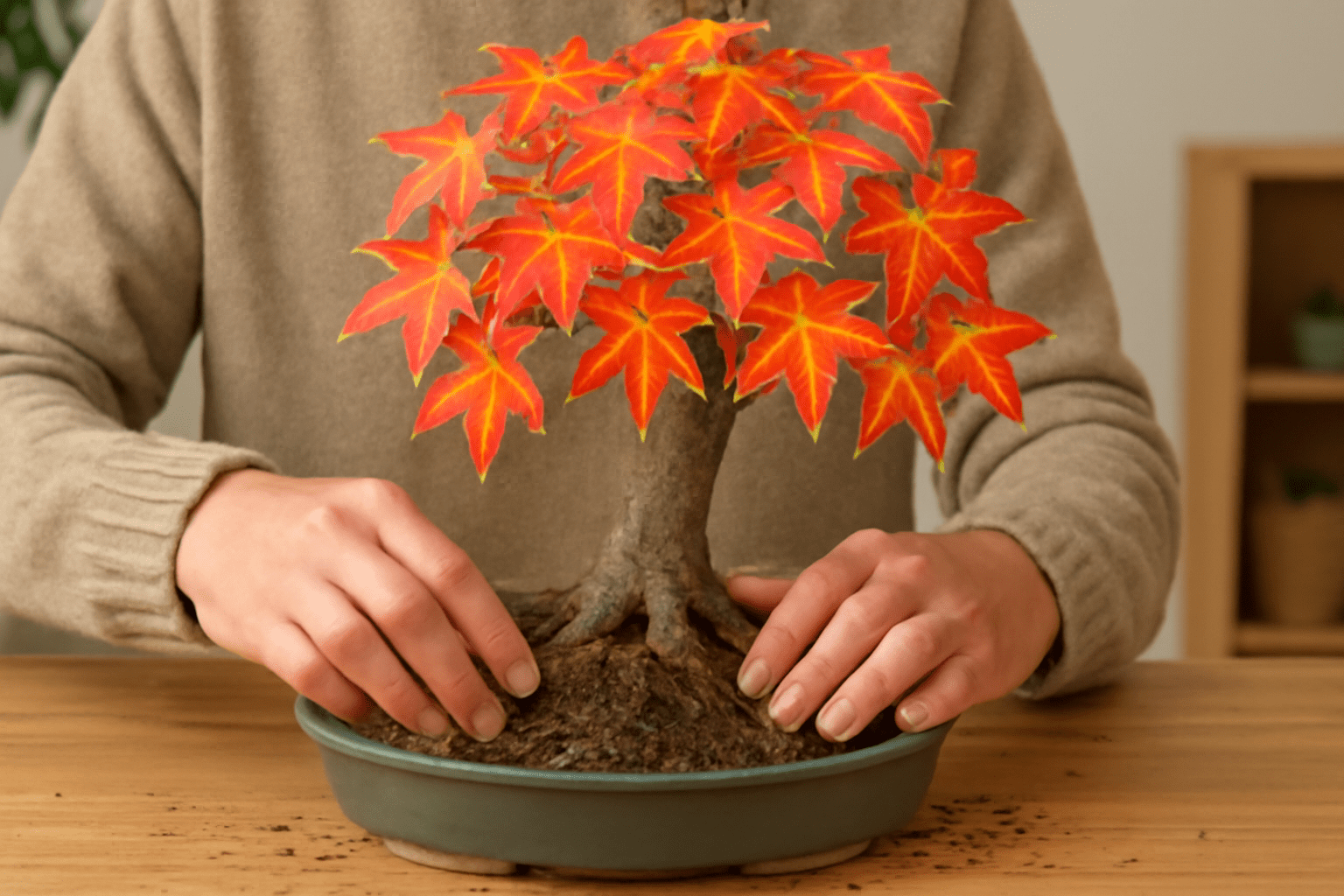
🏺🌱 1. Prepare Your Pot and Soil 🌱🏺
- Choose the Right Pot: As mentioned earlier, choose a shallow pot 🪴 with drainage holes 🌧️. Make sure it’s wide enough to accommodate the roots 🌳 but not too deep to prevent overgrowth 🌱.
- Prepare the Soil Mix: Use a well-draining bonsai soil mix 🌿, as discussed in the previous section. Make sure the soil is thoroughly mixed and ready to be placed in the pot 🏺.
🌿🌳 2. Remove the Tree from Its Nursery Pot 🌳🌿
- Gently Loosen the Roots: Carefully remove your American Sweetgum Bonsai 🌳 from its nursery pot. Gently tap the sides of the pot to release the tree without damaging the roots 🌱.
- Trim the Roots: Once the tree is out of the pot, trim any overly long or circling roots 🌿. This helps prevent root rot 🚫 and promotes better growth 🌱. Use sterilized pruning shears ✂️ to make clean cuts.
🪴🌳 3. Position the Tree in the Pot 🌳🪴
- Place the Tree in the Center: Position your tree 🌱 in the center of the pot 🏺, ensuring that the trunk 🌳 is upright and balanced ⚖️. If you’re working with a mature tree 🌳, it may have a specific orientation that suits its shape.
- Fill the Pot with Soil: Gently add soil around the roots 🌱, filling the pot 🏺. Use your fingers ✋ or a small stick to carefully push the soil between the roots 🌳. Avoid pressing too hard, as this can compact the soil and restrict airflow 🌬️ to the roots.
- Level the Soil: Once the tree is securely in place 🌳, level the soil to ensure an even surface 🏺. Leave a small gap (about half an inch) from the top of the pot to allow space for watering 💧.
💧🌿 4. Watering After Planting 🌿💧
- Initial Watering: After planting, water your American Sweetgum Bonsai 💦 thoroughly to help settle the soil around the roots 🌱. Ensure that excess water drains out of the bottom of the pot 🏺.
- Check for Air Pockets: If you notice any air pockets around the roots after watering 💧, gently tap the sides of the pot to help the soil settle further 🌱.
🌳🪴 5. Stabilize the Tree 🪴🌳
- Add Support (If Needed): If your tree 🌳 seems unstable, you can add small pieces of wire 🪢 or a root anchor 🪴 to hold the tree in place temporarily. This will help prevent the tree from shifting as it establishes its roots 🌱 in the new pot.
- Avoid Heavy Pruning: Don’t prune too much right after planting 🌱. Allow the tree to acclimate to its new environment 🏡 before making major cuts ✂️. Focus on watering 💧 and ensuring proper root growth 🌱 first.
☀️🌿 6. Positioning After Planting 🌿☀️
- Place in Indirect Sunlight: After planting 🌱, place your tree in a spot that receives indirect sunlight 🌞 for a few days. This helps reduce stress 😌 and allows the tree to recover from the transplanting process 🌿. Avoid direct sunlight immediately after planting to prevent burning 🔥.
- Monitor for Signs of Stress: Keep an eye 👀 on the tree over the next few weeks 🌱. Yellowing or wilting leaves 🍂 can indicate stress 😞. If you notice this, check the soil moisture levels 💧 and adjust watering as needed.
✂️🌳 Pruning and Shaping Your American Sweetgum Bonsai 🌳✂️
Pruning and shaping are essential parts of bonsai care, helping to maintain the tree’s health 🌱, structure 🌳, and aesthetic appeal 🌸. For your American Sweetgum Bonsai, proper pruning encourages strong branch development 💪 and ensures the tree stays compact and attractive 🌿. Let’s dive into the essentials of pruning and shaping your Sweetgum bonsai: 😊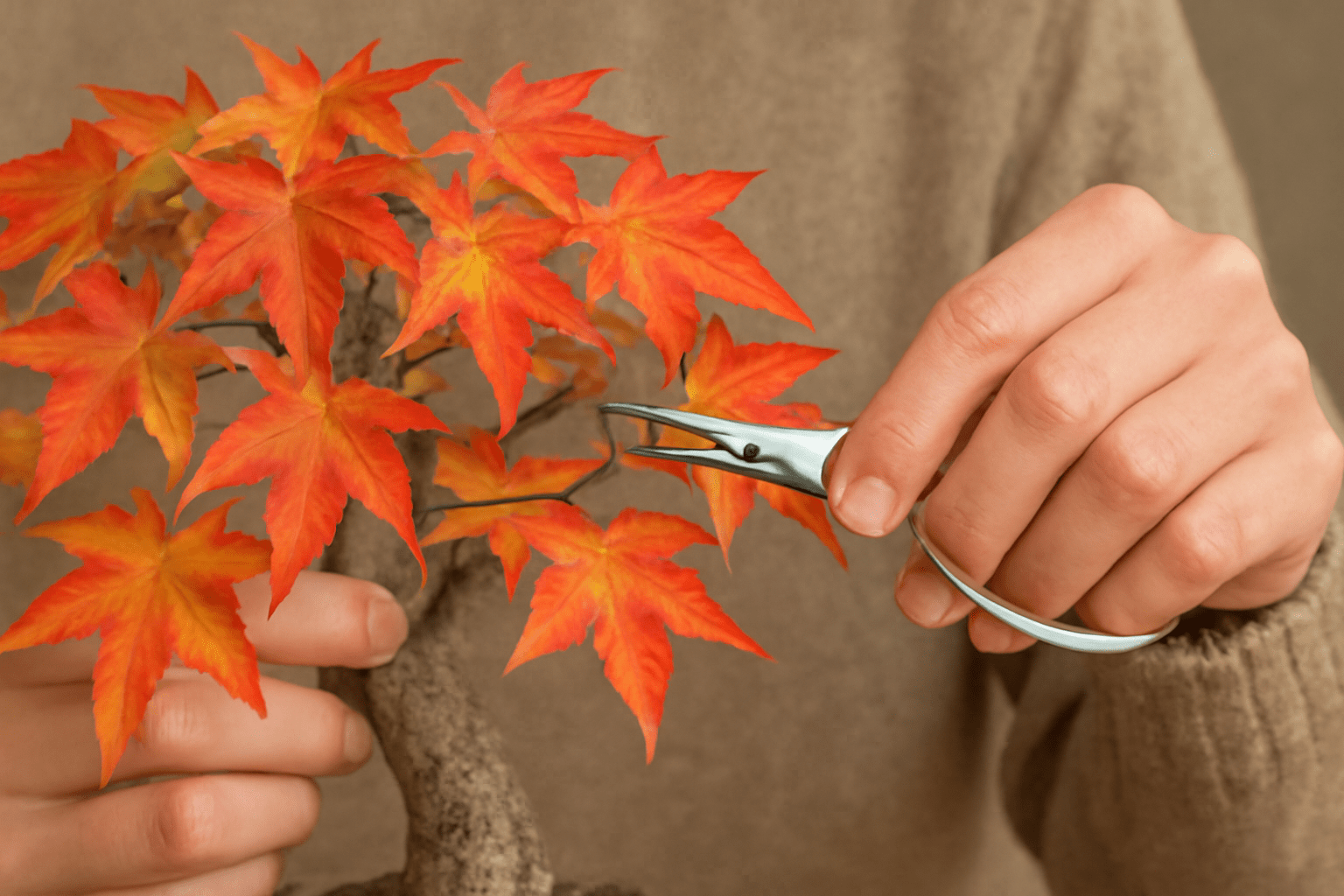
⏰🌱 1. When to Prune Your Bonsai 🌱⏰
- Best Time to Prune: The best time for pruning is during the growing season 🌞—typically in spring 🌸 or early summer 🌿—when the tree is actively growing. This helps it recover quickly from cuts ✂️ and promotes healthy new growth 🌱.
- Avoid Pruning in Winter: Avoid heavy pruning in winter ❄️, as the tree is in its dormant phase 💤 and may not heal as effectively. However, light pruning or removing dead leaves 🍂 can be done at any time.
✂️🌿 2. Pruning Techniques 🌿✂️
Pruning is not just about cutting ✂️—it’s about directing the growth and shaping the tree 🌳 to enhance its natural beauty 🌸. Here are some key pruning techniques:- Pinching Back New Growth: To encourage branching 🌱 and maintain a compact shape 🌿, pinch back the new shoots after they’ve grown a few inches. Use your fingers ✋ or pruning shears ✂️ to carefully trim the tips of the new growth.
- Cutting Long Branches: Remove any branches 🌳 that grow too long or out of shape. Cut them back to a point where there’s a healthy leaf node 🍃 (a small bump on the branch where leaves or new growth emerge). Always make clean, precise cuts ✂️.
- Thinning: Thin out dense areas of the tree 🌱 to improve airflow 🌬️ and light penetration ☀️. This is especially important if the tree’s canopy becomes too thick, as it can prevent lower branches from receiving enough sunlight 🌞.
🪢🌳 3. Shaping Your Bonsai with Wiring 🌳🪢
Wiring is a powerful tool to shape the branches and trunk of your American Sweetgum Bonsai 🌿. It helps guide the tree into the desired shape and allows you to create a more natural, visually appealing structure 🌳.- When to Wire: Begin wiring your bonsai once the branches 🌿 have started to grow and become flexible (usually after a year or two). Avoid wiring too early when the tree is still fragile 🪴.
- How to Wire: Start by wrapping the wire 🪢 around the base of the branch 🌱, working your way up towards the tip 🌿. Be careful not to wrap the wire too tightly, as this can damage the bark 🌳. Gradually bend the branch into the desired position, making sure not to snap it ⚠️.
- Removing the Wire: Once the branch 🌱 has set into position, remove the wire 🪢 after 6-12 months. Be sure to check periodically to ensure the wire hasn’t started to cut into the bark 🌳. If it has, carefully remove or reposition it ✂️.
🌿🌱 4. Creating a Balanced Tree Structure 🌱🌿
The goal of pruning and shaping is to create a balanced, aesthetically pleasing tree 🌳. Focus on the following when shaping:- Trunk Line: The trunk 🌳 should have a natural, flowing shape. Avoid cutting it too straight or rigid—let it curve gently for a more lifelike appearance 🌿.
- Branch Placement: Arrange branches 🌿 in layers, starting lower down on the trunk 🌱 and gradually placing higher branches further out. This will create a sense of depth and balance ⚖️ in the overall structure.
- Tapering the Trunk: A well-shaped bonsai trunk will taper from a thick base 🌳 to a thinner top 🌿. This gives the tree a more natural look 🌱, as real trees have thicker trunks at the base and thinner branches at the top 🌳.
💀🌱 5. Handling Dead or Damaged Parts 🌱💀
- Removing Dead Wood: Always remove any dead, broken, or diseased branches 🌿. This not only helps the tree look better 🌳 but also prevents the spread of disease 🦠 and encourages new growth 🌱.
- Caring for Cuts: Use a sealing paste for larger cuts ✂️ or wounds to help the tree heal faster 🌱 and prevent infection 🦠. For smaller cuts 🌿, it’s usually not necessary.
💧🌱 Watering and Fertilizing Your Sweetgum Bonsai 🌱💧
Watering and fertilizing are two key components of bonsai care 🌿 that directly impact the health 🌱 and growth 🌳 of your American Sweetgum Bonsai. Proper watering ensures the tree’s roots stay hydrated 💧 without becoming waterlogged, while the right fertilizer provides essential nutrients to promote growth 🌱. Let’s break down the essentials of watering and fertilizing your tree: 😊
💦🌿 1. Watering Your American Sweetgum Bonsai 🌿💦
Watering your bonsai correctly is crucial to its health 🌱. Overwatering or underwatering can cause stress and damage to the tree 🌳. Here’s how to get it right:- Check Soil Moisture: Always check the moisture level of the soil 🌱 before watering 💧. Stick your finger into the soil about an inch deep. If it feels dry, it’s time to water 💦. If it’s still moist, wait a day or two 🕑.
- Water Thoroughly: When you water 💧, make sure to water deeply 🌳 until water begins to drain out of the bottom of the pot 🏺. This ensures the roots 🌱 get enough moisture 💦. Use a watering can with a fine nozzle 🌧️ to avoid disturbing the soil.
- Avoid Standing Water: Never let your American Sweetgum Bonsai sit in water 🏺. After watering, ensure that excess water can drain freely from the pot 🌿 to prevent root rot 🌱.
- Watering Frequency: During the growing season (spring 🌸 and summer 🌞), you may need to water your bonsai every 2-3 days. In the cooler months (fall 🍂 and winter ❄️), watering frequency will reduce as the tree’s growth slows down.
🚱💧 2. Signs of Overwatering and Underwatering 💧🚱
It’s important to recognize the signs of both overwatering and underwatering 💧 to adjust your care accordingly:- Overwatering: Yellowing leaves 🍂, soft or mushy roots 🌱, and root rot 🛑 are signs that your tree 🌳 may be getting too much water 💦. Ensure that the pot has proper drainage 🌿 and avoid leaving the tree in waterlogged soil.
- Underwatering: Wilting leaves 🍃, dry soil 🌱, and brown tips on the leaves 🍂 indicate that the tree 🌳 is not getting enough water 💧. Increase watering 💦, but always check the soil moisture 🌱 before adding more water.
🌿💧 3. Fertilizing Your American Sweetgum Bonsai 💧🌿
Fertilizing helps replenish nutrients in the soil 🌱 and supports the healthy growth of your Sweetgum Bonsai 🌳. Since bonsai trees 🌱 live in small pots 🪴, they rely on you to provide the nutrients they need 💧.- Best Time to Fertilize: The ideal time to fertilize 🌿 is during the active growing season (spring 🌸 to early fall 🍂). Avoid fertilizing during winter ❄️ when the tree is dormant 💤.
- Types of Fertilizer:
- Balanced Fertilizer (10-10-10): Use a slow-release, balanced fertilizer 🌿 that contains equal parts nitrogen 🌱, phosphorus 🌿, and potassium 💧. This ensures the tree gets all the essential nutrients it needs for healthy growth 🌳.
- Liquid Fertilizer: You can also use a liquid fertilizer 💧, diluted to half-strength. This is ideal for more frequent feedings during the growing season 🌱.
- Fertilizing Schedule: Fertilize every 4-6 weeks 🌿 during the growing season 🌸. In winter ❄️, skip the fertilizer or use a very diluted version if your tree is still growing indoors 🏡.
- Organic Fertilizers: For a more natural approach 🌱, organic fertilizers like fish emulsion 🐟 or compost tea 🍂 can be used. These provide slow, steady nutrients 🌱 to your tree without the risk of over-fertilizing.
⚖️💧 4. How Much Fertilizer to Use 💧⚖️
Over-fertilizing can harm your tree 🌳, so always follow the manufacturer’s instructions 📋 on the fertilizer package. A general rule of thumb is to use small amounts of fertilizer 🌿 at regular intervals rather than a large dose at once 🪴. Too much fertilizer can burn the roots 🌱 and stunt growth 🌿. With proper watering 💧 and fertilizing 🌱, your American Sweetgum Bonsai 🌿 will have the nutrients it needs to thrive 🌳. Consistency is key 🔑—by maintaining a regular watering 💦 and fertilizing schedule, you’ll support the health of your tree 🌱 and help it flourish year-round 🌿.🌞🌿 Sunlight and Temperature Requirements 🌿🌞
Proper sunlight and temperature 🌡️ are crucial for the health of your American Sweetgum Bonsai 🌳. These environmental factors influence growth 🌱, leaf color 🍃, and overall vitality 🌿. Here’s what you need to know to keep your bonsai happy and thriving 😊: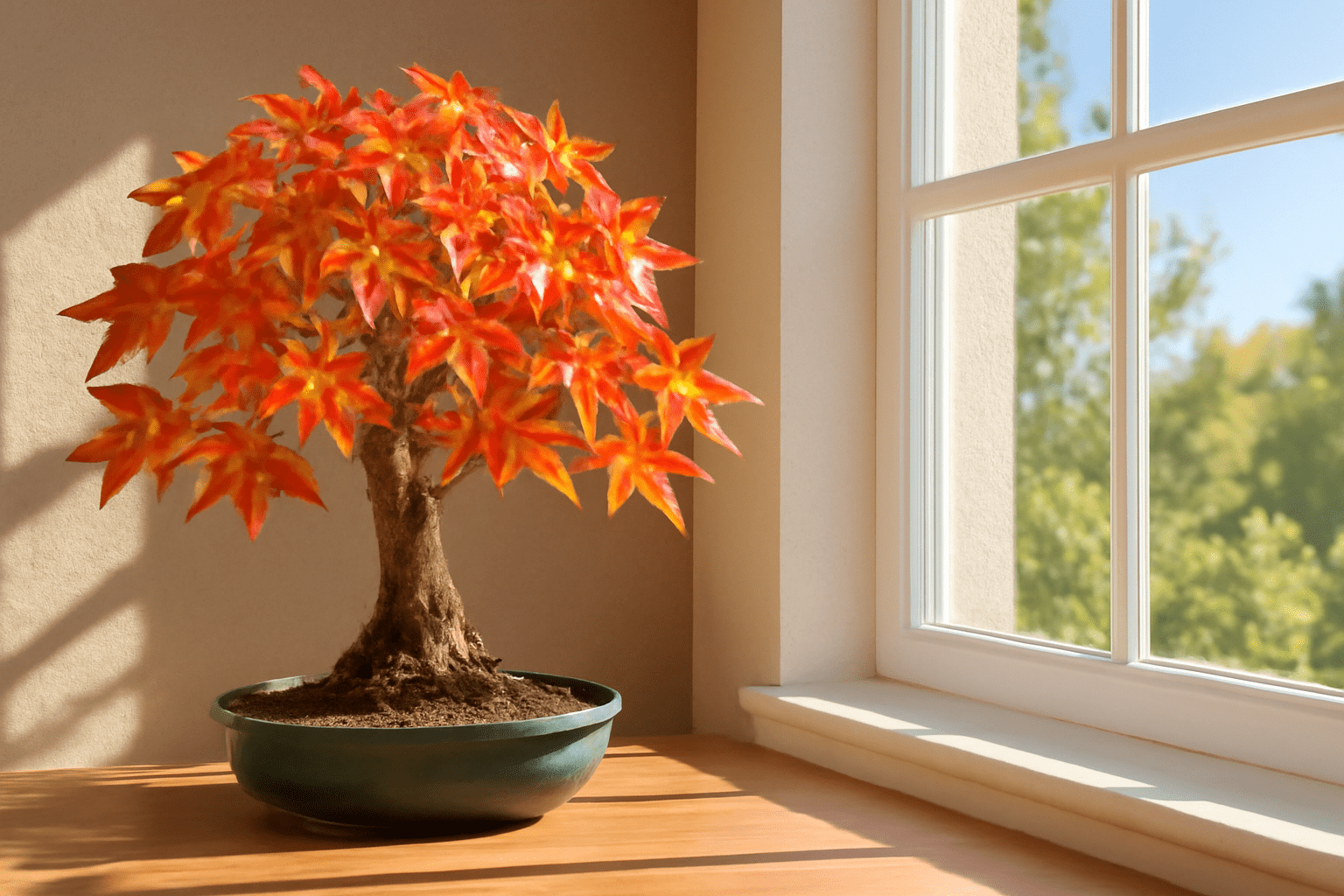
☀️🌱 1. Sunlight Needs 🌱☀️
- Ideal Light Exposure: American Sweetgum Bonsai trees thrive in full sunlight ☀️. Aim for at least 4-6 hours of direct sunlight per day 🌞 during the growing season (spring 🌸 and summer 🌞). The more sunlight 🌞, the healthier your tree 🌳 will be 🌱.
- Indoor Light: If you’re growing your Sweetgum bonsai indoors 🏠, place it near a south-facing window 🌞 where it can receive ample light 🌿. If natural light is insufficient 💡, consider using a grow light to supplement 🌱.
- Light Sensitivity: While the tree loves sunlight ☀️, it’s important to acclimate it to direct light 🌞 slowly if it has been kept in a lower-light environment 🏡. Sudden exposure to strong sunlight 🌞 can cause leaf burn 🍂.
🌡️🌿 2. Temperature Requirements 🌿🌡️
- Optimal Temperature Range: Your American Sweetgum Bonsai 🌱 prefers moderate temperatures 🌡️. The ideal range is between 60-75°F (15-24°C) during the growing season 🌱.
- Summer Heat: In the summer ☀️, the tree can tolerate warmer temperatures 🌞 but ensure it doesn’t exceed 90°F (32°C) for prolonged periods 🕒, as extreme heat 🌡️ can stress the tree 🌳 and cause leaves 🍂 to wilt.
- Winter Care: During the winter months ❄️, American Sweetgum Bonsai should be kept in a cool area 🏡, ideally between 45-60°F (7-15°C) ❄️. This helps the tree enter dormancy 💤 and prepare for the next growing season 🌱. If your tree is kept indoors 🏠, avoid placing it near heating vents or radiators 🔥, as this can dry out the air 💨 and stress the tree 🌳.
🍂🌱 3. Seasonal Considerations 🌱🍂
- Spring and Summer: During these seasons 🌸☀️, ensure your tree gets plenty of direct sunlight 🌞 and is kept in a moderately warm environment 🌱. Watering needs 💧 may increase, so keep an eye 👀 on the soil moisture 🌱.
- Fall and Winter: As temperatures drop 🍂, your tree’s growth will slow 🐌, and it will need less sunlight 🌞. Reduce watering 💦, and if your bonsai is kept indoors 🏠, avoid placing it near drafts 💨 or overly warm areas 🔥. If possible, give it a “chill” period ❄️ by moving it to a cooler location for the winter 🏡.
🧐🌿 4. Signs of Improper Light or Temperature 🌿🧐
- Too Little Sunlight: If your bonsai isn’t getting enough light 🌱, the leaves 🍂 may become pale or yellow, and growth 🌱 may become leggy (long, thin stems with few leaves).
- Too Much Sunlight: If the tree 🌳 is exposed to too much direct sunlight 🌞 too quickly, the leaves 🍃 may become scorched 🔥, developing brown spots or crispy edges 🌿. Gradually acclimate your tree 🌱 to stronger sunlight 🌞 to prevent this.
- Temperature Stress: If the temperature 🌡️ is too hot 🔥 or too cold ❄️, you may notice wilting 🍂, leaf drop 🍁, or slow growth 🌱. Ensure your tree is in a stable environment 🏡 that falls within the optimal temperature range 🌡️.
🛠️🌱 Common Problems and How to Solve Them 🌱🛠️
Every bonsai, including your American Sweetgum Bonsai 🌳, can face challenges along the way. Whether it’s pests 🐞, diseases 🦠, or environmental issues 🌱, it’s important to know how to identify and address problems early on. Here’s a guide to some common issues you might encounter with your Sweetgum bonsai 🌿, along with solutions to keep your tree healthy and thriving 😊: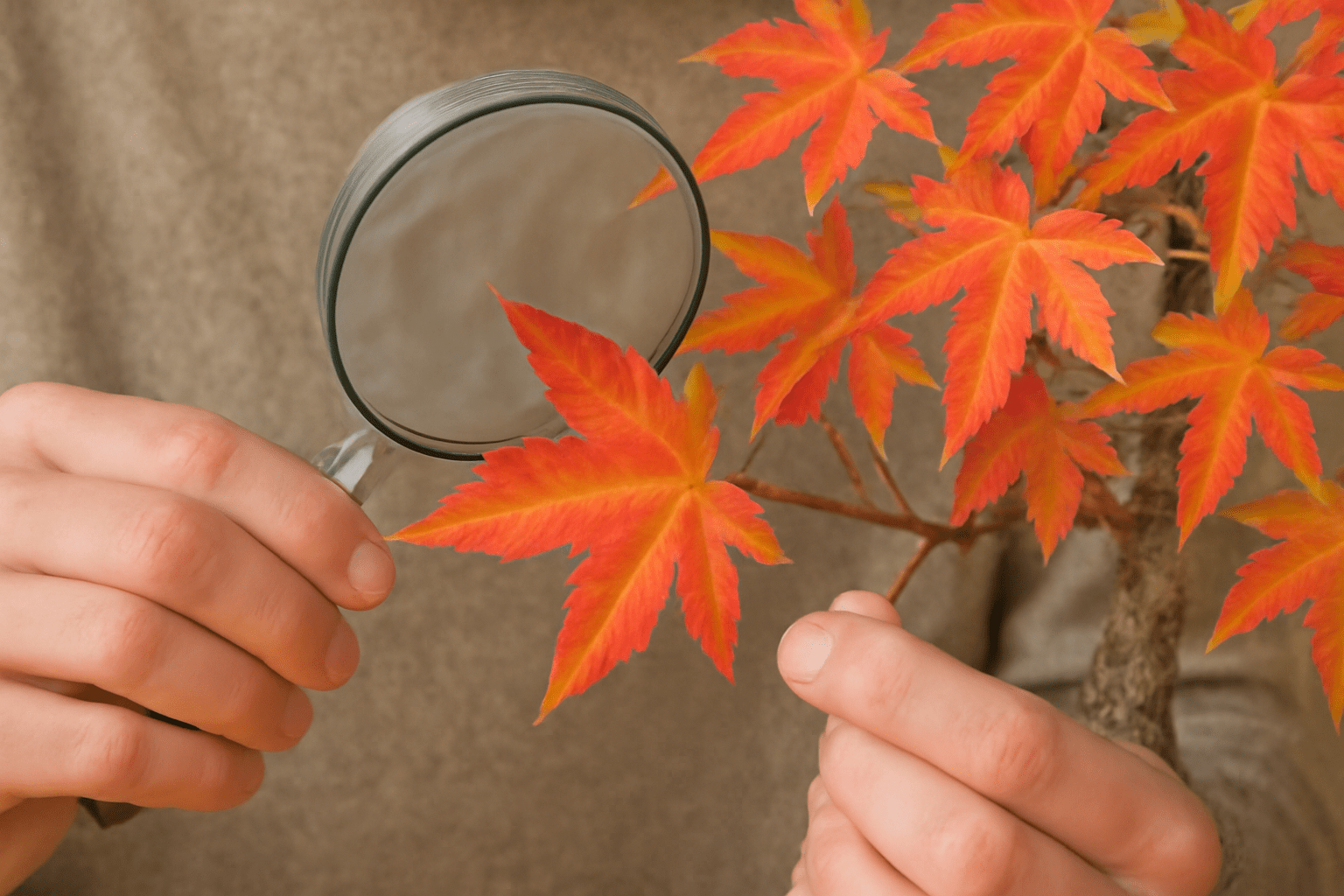
🍂🌿 1. Leaf Yellowing and Drop 🍂🌿
- Problem: One of the most common signs of stress 😔 in bonsai trees is yellowing or falling leaves 🍂. This can happen for several reasons, including overwatering 💧, underwatering 🚱, or nutrient deficiencies 🌱.
- Overwatering: Yellowing leaves 🍃 with soft, mushy roots 🌱 often point to root rot caused by overwatering 💧. Ensure the pot 🪴 has good drainage and avoid letting the tree sit in standing water 🌊.
- Underwatering: If the soil 🌱 is too dry, the tree 🌳 will also show yellowing leaves 🍂 and eventually drop them 🌿. Make sure you water 💦 regularly and deeply, especially during dry spells 🌞.
- Solution: Check the soil moisture 💧 levels regularly 🌱. If it’s overwatered, let the soil dry out before watering again 💦. If underwatered, give it a thorough watering 💧 and maintain a consistent watering schedule 🌱.
🥀🌿 2. Brown Leaf Tips 🥀🌿
- Problem: Brown tips on the leaves 🌿 are often caused by either too much sunlight 🌞 or inconsistent watering 💦.
- Too Much Sunlight: If your tree 🌳 is placed in too much direct sunlight 🌞, the leaf tips may scorch 🔥 and turn brown 🥀.
- Inconsistent Watering: If the tree 🌱 has been underwatered 🚱 or watered inconsistently 🌧️, this can also lead to dry, brown leaf tips 🍂.
- Solution: Move your bonsai to a location with indirect sunlight 🌞 and ensure that you’re watering 💧 it regularly but not excessively. Make sure the soil drains well 🌱 to prevent waterlogging 🏺.
🐞🌱 3. Pests and Insects 🌱🐞
- Problem: Like any plant 🌿, your American Sweetgum Bonsai 🌳 can attract pests 🦠 like aphids 🐜, spider mites 🕷️, or scale insects 🦗. These pests can damage the leaves 🍃 and stunt growth 🌱 if left untreated.
- Aphids: Small, greenish insects 🐜 that cluster on new shoots 🌱 and leaves 🍃, causing curling and distortion 🌿.
- Spider Mites: Tiny, spider-like pests 🕷️ that leave webbing 🕸️ on the leaves 🍃 and cause a speckled appearance 🌿.
- Scale Insects: Small, hard, and brown bumps 🦗 on the leaves 🍂 and stems 🌿 that can block nutrient flow 🛑.
- Solution: For aphids 🐜 and spider mites 🕷️, use a mild insecticidal soap 🧴 or a mixture of water 💧 and neem oil 🌿. For scale insects 🦗, remove them manually with a cotton swab soaked in rubbing alcohol 💧, or use an insecticidal soap 🧴. Always inspect your tree regularly 👀 for signs of infestation 🦠.
🛑🌱 4. Root Rot 🌱🛑
- Problem: Root rot is a serious issue ⚠️ caused by overwatering 💧 and poor drainage 🏺. If left unchecked 🚫, it can kill your American Sweetgum Bonsai 🌳.
- Symptoms: Blackened, mushy roots 🌱, along with yellowing or wilting leaves 🍂, are signs of root rot 🛑.
- Solution: Remove the tree 🌳 from its pot 🪴 and inspect the roots 🌱. Trim away any soft, blackened roots 🖤 with sterilized scissors ✂️. Repot the tree 🌳 in fresh, well-draining bonsai soil 🪴, and ensure the pot has good drainage 🌿. Adjust your watering 💧 routine to avoid overwatering in the future 🚱.
🌱🌿 5. Stunted Growth 🌿🌱
- Problem: If your American Sweetgum Bonsai 🌳 is growing slowly or showing little new growth 🌱, it might be lacking essential nutrients 🍂 or not receiving enough light 🌞.
- Lack of Fertilizer: Bonsai trees 🌿 need regular feeding 🍽️ to promote healthy growth 🌱. A lack of nutrients can cause stunted growth 🚫.
- Insufficient Light: If the tree 🌳 is not getting enough sunlight 🌞, its growth will slow ⏳, and it will become leggy (long, thin stems with few leaves 🍂).
- Solution: Feed your tree 🌱 with a balanced bonsai fertilizer 🍃 every 4-6 weeks during the growing season 🌸. If it’s indoors 🏠, move it to a sunnier location 🌞 or use grow lights 💡 to ensure it gets enough light 🌱.
🌾🌿 6. Leaf Curling and Wilting 🌿🌾
- Problem: Leaf curling 🍃 and wilting 🌱 are signs that your tree is stressed 😞, often due to environmental factors like inconsistent watering 💧 or temperature extremes 🌡️.
- Inconsistent Watering: If the soil 🌱 has been too dry or too wet 💧, the leaves 🍂 may curl and wilt 🌱 as the tree struggles to maintain hydration 💧.
- Temperature Stress: Extreme temperatures 🌡️, whether too hot 🔥 or too cold ❄️, can cause the leaves 🍃 to curl and wilt 🌱.
- Solution: Ensure your Sweetgum Bonsai 🌱 has a consistent watering 💧 schedule. Avoid temperature extremes 🌞❄️ by placing it in a moderate climate 🌿 and protecting it from drafts 🌬️, direct heat 🔥, or freezing temperatures ❄️.
🌿🌱 7. Leggy Growth (Long, Thin Stems) 🌱🌿
- Problem: Leggy growth 🌱 occurs when your bonsai isn’t receiving enough light 🌞, or when it hasn’t been properly pruned ✂️.
- Lack of Sunlight: If the tree 🌳 is placed in low light 🌑, the branches 🌿 will stretch toward the light source ☀️, creating long, thin growth 🌱.
- Failure to Prune: Not trimming ✂️ the bonsai regularly will result in a sparse structure 🌿 with long, leggy branches 🌱.
- Solution: Ensure your tree 🌱 gets enough direct sunlight 🌞 (at least 4-6 hours per day 🌞) and prune ✂️ it regularly to maintain its shape and compact size 🌿.
🍂🌳 Seasonal Care for Your American Sweetgum Bonsai 🌳🍂
Seasonal changes significantly impact your American Sweetgum Bonsai 🌱, and adjusting its care throughout the year is essential for maintaining its health 🌿 and beauty 🌸. By adapting your care routine to the seasons, you can ensure your tree thrives 🌳 no matter the time of year 🌞. Here’s how to manage seasonal care for your Sweetgum bonsai: 😊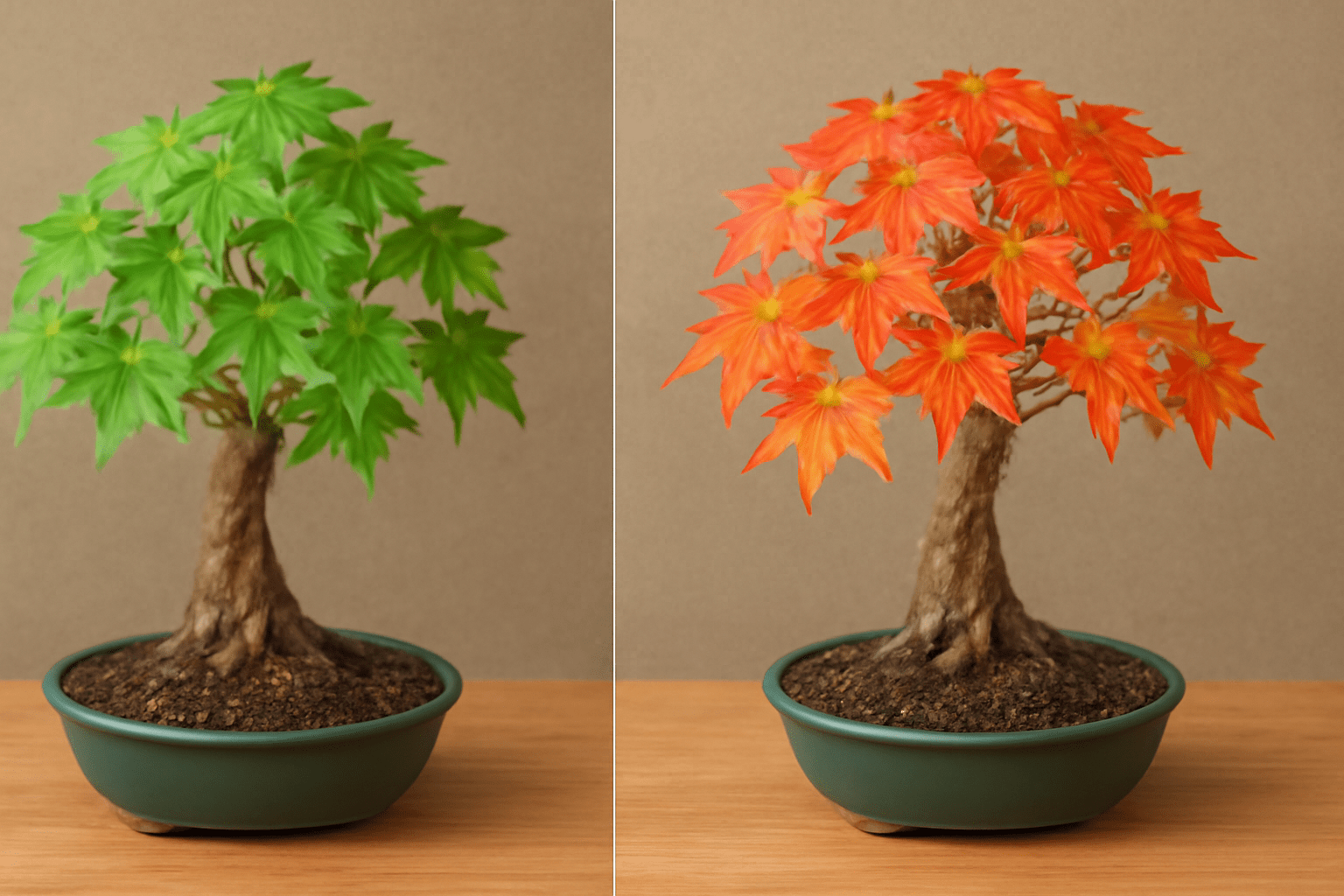
🌞🌿 1. Spring and Summer Care (Growing Season) 🌿🌞
- Sunlight Needs: During spring 🌸 and summer 🌞, your American Sweetgum Bonsai 🌳 will experience its active growth phase. Place your tree in full sunlight ☀️ for at least 4-6 hours a day 🌞 to promote healthy leaf development 🍃 and vibrant colors 🌱.
- Watering: The tree 🌳 will need more water 💦 during the warmer months 🌞. Check the soil frequently 🌱 to ensure it stays moist 💧 but not soggy 🌿. Water thoroughly when the top inch of soil feels dry 🌱.
- Pruning and Shaping: Spring 🌸 and early summer 🌿 are the best times for pruning ✂️ and shaping your bonsai 🌳. Trim back any overgrown branches 🌿 and pinch new shoots 🌱 to maintain a compact, attractive shape. You can also start wiring the branches 🪢 for shaping if your tree is mature enough.
- Fertilizing: As your tree 🌳 actively grows 🌱, it needs regular nutrients 🥗. Use a balanced fertilizer 🌿 every 4-6 weeks 🌱 to support healthy growth. Organic or slow-release fertilizers 🌿 work well during this time 🌞.
🍁🌿 2. Fall Care (Transition to Dormancy) 🍁🌿
- Sunlight and Temperature: As the weather cools 🍂, your Sweetgum Bonsai 🌳 will begin preparing for dormancy 💤. If it’s outdoors 🌳, reduce the amount of direct sunlight 🌞 to simulate the natural transition to fall 🍂. Indoors 🏠, maintain moderate temperatures around 60-65°F (15-18°C) 🌿.
- Watering: While the tree’s growth slows 🌱 in the fall 🍁, you should still check the soil’s moisture 💧. Water sparingly 💦, but don’t allow the soil 🌱 to completely dry out 🍂.
- Leaf Color: One of the highlights 🌟 of the American Sweetgum Bonsai is its vibrant fall foliage 🍁. Enjoy the stunning transformation of the leaves 🍂 as they change color 🌈 to brilliant red, orange 🍊, and yellow 🍃! This is a natural process 🌿 and a beautiful part of your tree’s lifecycle 🌳.
- Prepare for Winter: If the weather is still mild 🌞, you can keep your tree outdoors 🌳. However, if you’re in an area with harsh winters ❄️, consider bringing your tree indoors 🏠 to protect it from extreme cold 🌬️.
❄️🌱 3. Winter Care (Dormant Period) 🌱❄️
- Temperature and Light: During the winter months ❄️, American Sweetgum Bonsai 🌳 enters a dormant phase 💤. Keep it in a cool room 🏡 or a sheltered outdoor space 🌲 where temperatures range from 45-60°F (7-15°C) 🌡️. Avoid placing it in locations with fluctuating temperatures 🌡️, such as near heating vents 🔥 or windows 🌞.
- Watering: Your tree 🌳 will need less water 💦 during dormancy 💤. Water the bonsai 💧 only when the top layer of soil feels dry, typically every 2-3 weeks 🌱. Overwatering 🚫 can lead to root rot 🌱, so be cautious!
- Reduced Growth: During the winter 🥶, expect minimal to no growth 🌱. This is the tree’s resting period 💤, so avoid heavy pruning ✂️ or shaping 🪴. Allow the tree 🌳 to conserve energy ⚡ and rest until spring 🌸.
- Humidity: Indoor environments 🏠 during winter can be dry 🏜️, especially with heating systems running 🔥. Consider placing a humidity tray 🌊 (a shallow dish with pebbles and water 💧) under your tree 🌳 or misting it occasionally to maintain moisture levels in the air 💦.
🌼🌱 4. Spring Transition (Preparing for Active Growth) 🌱🌼
- Repositioning for Sunlight: As the days get longer and warmer 🌞, move your American Sweetgum Bonsai 🌳 back to a location with more sunlight 🌞. If it’s been indoors 🏠 during the winter 🥶, gradually reintroduce it to outdoor conditions 🌞 to avoid shock from direct sunlight 🌞.
- Repotting (if necessary): Spring 🌸 is a good time to repot your bonsai 🪴 if it has outgrown its current pot 🏺 or if the soil has become compacted 🌱. Carefully trim the roots 🌿 and replace the old soil with fresh, well-draining bonsai mix 🪴 to support the tree’s growth in the new season 🌿.
- Fertilizing and Watering: Increase watering 💧 frequency as the temperature rises 🌞, and resume a regular fertilizing schedule 🗓️ to support your tree’s new growth 🌱.
🍂🪴 Bonus Section: Troubleshooting Common Issues with Your Sweetgum Bonsai 🪴🍂
Even with the best care 🌱, your American Sweetgum Bonsai 🌳 may face a few challenges along the way. But don’t worry! Troubleshooting is an essential skill for any bonsai enthusiast 🧑🌾, and with the right approach, you can address common issues and keep your tree thriving 🌿. Let’s explore some of the most frequent problems you might encounter and how to solve them effectively 😊:🌱💪 1. Stunted Growth or Lack of New Growth 🌱💪
- Problem: Your American Sweetgum Bonsai 🌳 isn’t growing as expected, and there’s little new growth 🌿 during the spring 🌸 or summer 🌞.
- Possible Causes:
- Lack of sunlight 🌞: Ensure your tree 🌳 is getting at least 4-6 hours of direct sunlight ☀️ each day.
- Nutrient deficiency 🍂: The tree may not be getting enough nutrients, especially if you’ve skipped fertilizing 🌿.
- Root-bound 🪴: If the roots 🌱 have outgrown the pot 🪴, it can restrict growth 🌱.
- Solution:
- Move your tree 🌱 to a sunnier spot 🌞 or use grow lights 💡 if indoors 🏡.
- Fertilize regularly 🌱 during the growing season 🌿 using a balanced, slow-release fertilizer 💧.
- Consider repotting 🪴 your tree if it’s become root-bound 🌱.
🌾🍂 2. Leaf Curling and Wilting 🍂🌾
- Problem: The leaves 🍃 on your Sweetgum Bonsai 🌳 are curling or wilting 🌱, and the tree looks stressed 🌿.
- Possible Causes:
- Inconsistent watering 💧: Underwatering 🚱 or overwatering 💦 can cause the leaves 🍂 to curl and wilt.
- Environmental stress 🌬️: Excessive heat 🌡️, drafts 🌬️, or temperature fluctuations 🌡️ can also cause this.
- Solution:
- Ensure consistent watering 💧. Check the soil moisture 🌱 regularly, and avoid letting the tree sit in standing water 💦.
- Keep your tree 🌳 in a stable environment 🏡 with moderate temperatures 🌞 and protect it from direct drafts 🌬️ or heat 🔥 sources.
🍂🌿 3. Yellowing Leaves 🍂🌿
- Problem: The leaves 🍃 of your American Sweetgum Bonsai 🌳 are turning yellow 🍂, and the tree looks unhealthy 🥀.
- Possible Causes:
- Overwatering 💦: Root rot can occur if the tree is sitting in waterlogged soil 🏺.
- Nutrient deficiencies 🌱: Yellowing leaves 🍃 can also indicate a lack of essential nutrients 🌿, especially nitrogen.
- Pests 🐞: Aphids, spider mites 🕷️, or other insects 🦠 can cause yellowing 🍂 and damage 🌱.
- Solution:
- Check the soil drainage 🌿 and adjust your watering 💦 routine. Ensure the tree 🌳 is not sitting in excess water 💧.
- Fertilize with a balanced, liquid fertilizer 🌿 to replenish nutrients 🌱.
- Inspect the tree 🍃 for pests 🐞, and treat it with an organic insecticidal soap 🧴 or neem oil 🌿 if needed.
🥀🌱 4. Brown Leaf Tips 🥀🌱
- Problem: The tips 🌿 of the leaves 🍃 are turning brown 🥀 and dry 🌱.
- Possible Causes:
- Low humidity 💨: Bonsai trees 🪴, especially when kept indoors 🏠, may suffer from dry air 🌬️, especially during the winter ❄️.
- Too much sunlight 🌞: If your tree 🌳 is exposed to too much direct sunlight 🌞 too quickly, it can scorch 🔥 the leaves 🍂.
- Solution:
- Increase humidity 🌿 around the tree 🌳 by placing it on a humidity tray 🪴 or misting the leaves 🍃.
- Gradually acclimate your tree 🌱 to direct sunlight ☀️ to avoid burning, and make sure it’s not sitting in intense sunlight 🔆 for long periods 🌿.
🐞🌿 5. Pests or Insects 🌿🐞
- Problem: You notice small insects 🐜, webbing 🕸️, or spots on the leaves 🍃 and branches 🌿.
- Possible Causes:
- Aphids 🐜, spider mites 🕷️, scale insects 🦗, or mealybugs 🐛 can infest your tree 🌳 and cause damage 🛑.
- Solution:
- For spider mites 🕷️, aphids 🐜, and mealybugs 🐛, use a mild insecticidal soap 🧴 or neem oil solution 💧 to gently spray your tree 🌿.
- For scale insects 🦗, you can manually remove them using a cotton swab 💧 dipped in rubbing alcohol 🧴.
- Regularly check your tree 🍃 for pests 🐞, especially in spring 🌸 and summer 🌞, and treat them promptly 🧴 to avoid further damage 🛑.
🛑🌱 6. Root Rot 🌱🛑
- Problem: The tree 🌳 is showing signs of wilting 🍂, yellowing leaves 🍃, and soft, mushy roots 🌱.
- Possible Causes:
- Overwatering 💦: This is the most common cause of root rot 🌱. If the roots 🌿 remain in soggy soil for too long 🌊, they become prone to decay 🦠.
- Solution:
- Remove the tree 🌳 from its pot 🪴 and inspect the roots 🌱. Trim any rotten or blackened roots 🖤 with sterilized scissors ✂️.
- Repot the tree 🌳 in fresh, well-draining bonsai soil 🪴 and ensure the pot has proper drainage 🌱.
- Adjust your watering schedule 💦 to avoid overwatering in the future 🚱. Always check soil moisture before watering 💧.
🍃🌿 7. Leaf Drop (Sudden or Gradual) 🌿🍃
- Problem: Your American Sweetgum Bonsai 🌳 is dropping leaves 🍂 unexpectedly 🌱, or it’s losing leaves gradually 🍃 over time.
- Possible Causes:
- Seasonal change 🍂: Leaf drop 🍂 is natural during autumn 🍁, but if it occurs in other seasons 🌱, it could be due to stress 😞.
- Stress from changes in environment 🏠: Moving the tree 🌳 to a new location or sudden temperature fluctuations 🌡️ can cause leaf drop 🍂.
- Solution:
- If it’s fall 🍂, the leaf drop is natural 🍁, and you can expect new growth in spring 🌸.
- If the leaf drop is unrelated to the season 🍂, check the environment 🏠 for any temperature 🌡️ or humidity changes 💧 and try to stabilize it 🌱.
- Avoid drastic changes to the tree’s environment 🌱 unless necessary, and give it time ⏳ to acclimate 🪴.
🌱💚 Final Thoughts on Troubleshooting 🌱💚
By understanding common issues 🛠️ and knowing how to address them 🌿, you’ll be better equipped to care for your American Sweetgum Bonsai 🌳. Regular monitoring 👀, proper care 🧑🌾, and timely intervention ⏱️ are key to keeping your bonsai healthy 🌱. With patience and the right approach 🌱, your Sweetgum will thrive 🌿 and continue to provide beauty and serenity 🧘♂️ for years to come 🌳💚.🌟🌱 Final Thoughts 🌱🌟
Caring for an American Sweetgum Bonsai 🌳 is a rewarding and fulfilling experience 🌱 that combines the beauty of nature 🌿 with the art of bonsai cultivation 🎋. By following the tips and techniques outlined in this guide 📖, you’ll be well on your way to creating a healthy, vibrant tree 🌳 that brings joy to your home 🏡 or garden 🌿. Remember, bonsai care requires patience ⏳ and consistency 🔄, but the rewards are well worth it 💚. Whether you’re enjoying the brilliant fall foliage 🍁, shaping your tree 🌱 through pruning ✂️ and wiring 🪢, or simply relaxing 🧘♂️ with your bonsai 🌿, every step will deepen your connection with nature 🌍.
Frequently Asked Questions (FAQ)
How often should I water my American Sweetgum Bonsai?
Water your American Sweetgum Bonsai when the top inch of soil feels dry to the touch. During the growing season (spring and summer), you may need to water every 2-3 days, while in cooler months, reduce watering to once a week. Always ensure the pot has proper drainage to avoid waterlogging. 💧
Can I grow an American Sweetgum Bonsai indoors?
Yes, you can grow an American Sweetgum Bonsai indoors, but it needs plenty of sunlight. Place it near a south-facing window or use a grow light to ensure it gets at least 4-6 hours of direct sunlight per day. 🌞
What is the best fertilizer for my Sweetgum Bonsai?
Use a balanced, slow-release fertilizer (like 10-10-10) every 4-6 weeks during the growing season (spring and summer). This provides the necessary nutrients for healthy growth and vibrant leaves. Avoid fertilizing during winter when the tree is dormant. 🌿
How do I prune my American Sweetgum Bonsai?
Prune your American Sweetgum Bonsai by cutting back long, leggy growth and removing dead or damaged branches. Do this in the spring or early summer, when the tree is actively growing. Pinch back new growth to encourage branching and maintain a compact shape. ✂️
Why are the leaves of my Sweetgum Bonsai turning yellow?
Yellowing leaves can be caused by overwatering, underwatering, or a nutrient deficiency. Check the soil moisture regularly to ensure it’s not too wet or too dry. If the issue persists, consider feeding your tree with a balanced fertilizer. 🌱
When should I repot my American Sweetgum Bonsai?
Repot your Sweetgum Bonsai every 2-3 years, ideally in early spring before the growing season begins. This gives the roots room to grow and ensures the soil remains nutrient-rich and well-draining. 🪴
How much sunlight does an American Sweetgum Bonsai need?
Your American Sweetgum Bonsai needs at least 4-6 hours of direct sunlight each day to thrive. In winter, it’s essential to provide sufficient light, either through natural sunlight or supplemental grow lights. 🌞
Why is my Sweetgum Bonsai dropping leaves?
Leaf drop can be a natural process, especially in the fall when the tree is preparing for dormancy. However, if this happens at other times, it could indicate stress from factors like temperature changes, pests, or improper watering. Check the environment and care routine to troubleshoot. 🍂
